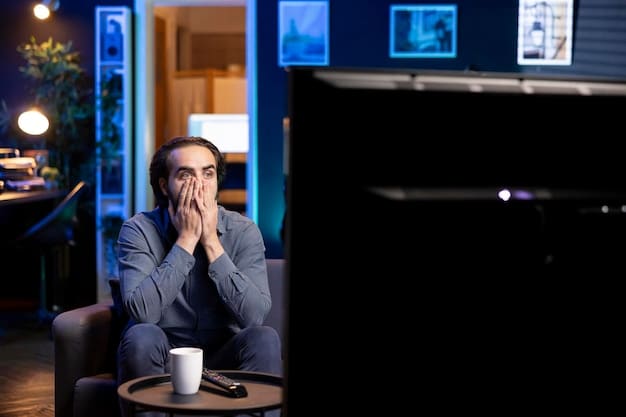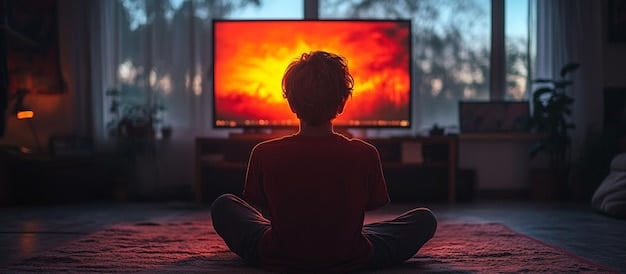Binge-Watching Burnout: 3 Strategies to Enjoy Series

To counteract binge-watching burnout and maintain enjoyment of your favorite series, implement strategic viewing breaks, diversify your entertainment choices, and engage actively with the content to foster a positive and sustainable viewing habit.
In an era saturated with endless streaming options, the allure of continuous content consumption is undeniable. Yet, the very act that brings so much pleasure can, paradoxically, lead to a phenomenon known as binge-watching burnout. This deep exhaustion, not just physical but often mental and emotional, can transform the joy of discovery into a mundane chore, leaving viewers feeling drained rather than entertained. Understanding this modern affliction is the first step toward reclaiming the vibrant world of storytelling without succumbing to its pitfalls. This article delves into three proven strategies to help you navigate the vast cinematic landscape, sidestep burnout, and genuinely savor every episode.
Understanding the Binge-Watching Phenomenon
Binge-watching, the practice of watching multiple episodes of a television program in rapid succession, has become a cornerstone of modern entertainment. Fuelled by instant access to entire seasons, this viewing habit offers an undeniable appeal: the immediate gratification of narrative progression, the elimination of cliffhanger waiting periods, and the immersive experience of a cohesive story arc. It’s a compelling escape, a way to dive deep into fictional worlds, connecting with characters and plotlines on an intense level. However, beneath this engaging surface lies a potential for diminishing returns, where quantity can erode quality of experience.
The transition from a casual viewer to a dedicated binge-watcher often happens subtly. One episode turns into two, then five, until suddenly hours have vanished, and the sun is rising on a new day. This immersive quality, while initially exhilarating, can blur the lines between reality and fiction, impacting sleep cycles, social interactions, and even daily routines. The brain’s reward system, accustomed to constant dopamine hits from narrative progression, can begin to expect this continuous stimulation, leading to a feeling of withdrawal or emptiness when the show ends, or even worse, during the watch itself if exhaustion sets in.
The Psychology Behind the Habit
Delving into the psychological underpinnings of binge-watching reveals a complex interplay of factors driving this pervasive behavior. Our brains are hardwired for narrative; stories provide meaning, help us process information, and offer emotional catharsis. Streaming platforms capitalize on this inherent human need by presenting content in easily consumable, interconnected chunks. The “next episode” button, often appearing automatically, acts as a powerful psychological trigger, minimizing the effort required to continue viewing and exploiting our natural tendency towards inertia.
- Dopamine Rush: Each plot twist, character development, or resolution of a mystery triggers a release of dopamine, the brain’s “reward” chemical, creating a sense of pleasure and encouraging continued viewing.
- Escapism and Comfort: For many, binge-watching offers a potent form of escapism, a temporary refuge from daily stressors or anxieties. The predictable comfort of familiar characters and narratives can be deeply soothing.
- Social Connection: While often a solitary activity, binge-watching can also foster social bonds, enabling shared experiences and discussions with friends or online communities.
However, this constant stimulation, without adequate breaks or diversification, can lead to sensory overload. The brain, constantly processing new information and emotional arcs, can become fatigued, much like a muscle after an intense workout. This mental exhaustion manifests not just as tiredness, but as a reduced capacity for focus, decision-making, and even emotional regulation. The initial joy of discovery gives way to a dull ache, a feeling of being force-fed content rather than willingly consuming it.
Recognizing the psychological mechanisms at play is crucial because it allows us to approach binge-watching with a greater sense of intentionality and self-awareness. It moves us beyond simply “watching too much TV” to understanding that this habit, like any other, has both benefits and potential drawbacks for our mental landscape. Ultimately, the goal is not to demonize binge-watching, but to understand how to leverage its positive aspects while mitigating the risks of burnout, ensuring that our entertainment remains a source of genuine enjoyment rather than an obligation.
Strategy 1: Embrace Mindful Viewing Habits
The first and perhaps most foundational strategy to combat binge-watching burnout is to cultivate mindful viewing habits. This isn’t about rigid restrictions, but rather about bringing conscious awareness to how, when, and why we consume content. Instead of passively letting algorithms dictate our next move, mindful viewing encourages us to reclaim agency over our entertainment choices, transforming a potentially draining activity into a genuinely restorative one. It’s about quality over quantity, presence over perpetual motion.
A key aspect of this strategy involves setting clear boundaries around viewing sessions. Just as we wouldn’t eat an entire day’s worth of meals in one sitting, understanding that our brains need time to process and assimilate narratives is vital. This might mean deciding beforehand how many episodes you’ll watch, or explicitly scheduling breaks between them. These pauses aren’t interruptions; they are essential moments for reflection, for stepping back from the screen, and for allowing the story to settle within you, rather than simply rushing to the next chapter.

Scheduled Breaks and Time Limits
Implementing scheduled breaks and strict time limits are practical applications of mindful viewing. The “next episode” autoplay feature, while convenient, is a primary driver of mindless consumption. Disabling it or manually intervening is a small yet powerful act of self-control that can significantly impact your viewing patterns. Consider these actionable steps:
- The “One-Episode-At-A-Time” Rule: After each episode, consciously decide if you want to watch another. Don’t let autoplay make the decision for you. This pause allows you to check in with yourself.
- Set a Timer: Before you start a session, decide on a total viewing time (e.g., 90 minutes). Set an alarm, and when it goes off, pause the show, even if mid-episode. This builds discipline.
- Episode Buffers: If you’re deep into a compelling series, plan for a buffer. Watch two episodes, then take a 15-20 minute break. Stand up, stretch, grab a snack, or just look away from the screen.
- Weekend Windows: Instead of free-form weekend binges, designate specific “viewing windows” – say, Saturday night from 7 PM to 10 PM. Outside these windows, engage in other activities.
These structured approaches help decentralize entertainment from being the sole focus of your leisure time. They create space for other activities, whether it’s reading, pursuing a hobby, connecting with friends offline, or simply enjoying quiet reflection. The goal is to prevent series from completely dominating your schedule, ensuring a balanced and fulfilling life beyond the screen. This proactive scheduling helps to mitigate the feeling of obligation often associated with burnout, transforming viewing into a chosen activity rather than an automatic default.
Active Engagement vs. Passive Consumption
Beyond setting boundaries, shifting from passive consumption to active engagement is fundamental to mindful viewing. Passive consumption often involves background viewing, multitasking, or simply letting the narrative wash over you without deep thought. While there’s a place for light entertainment, continuous passive viewing can be mentally unsatisfying, leaving you feeling empty rather than enriched. Active engagement, conversely, transforms watching into a more enriching experience.
To cultivate active engagement, consider these practices:
- Discuss and Debate: Engage with friends or online communities about the series. Discuss plot theories, character motivations, or thematic elements. This deepens your understanding and appreciation.
- Take Notes or Journal: For particularly intricate or thought-provoking shows, jot down observations, questions, or emotional reactions. This encourages critical thinking and personal connection.
- Research and Explore: Look up behind-the-scenes information, interviews with the creators, or historical contexts related to the show. This expands your knowledge and appreciation for the craft.
- Mindful Pauses: Instead of constantly hitting “next,” hit “pause.” Reflect on a powerful scene, a compelling dialogue, or a stunning visual. Allow yourself to truly absorb and react to the moment.
By actively engaging with the content, you transform the viewing experience from a mere time-filler into a more stimulating and rewarding activity. This conscious effort encourages critical thought and emotional resonance, leading to a deeper satisfaction that counteracts the superficiality of burnout. It shifts the focus from simply finishing a series to truly experiencing and appreciating the art form, making your entertainment choices deliberate and enriching.
Strategy 2: Diversify Your Leisure Activities
One of the most effective ways to circumvent binge-watching burnout is to actively diversify your leisure activities. When prolonged immersion in screen-based entertainment becomes the primary, or sole, method of relaxation and enjoyment, it can lead to a narrowness of experience that eventually breeds boredom and fatigue. The human mind thrives on variety and different forms of stimulation. Therefore, consciously widening your horizons beyond the glowing screen is not just a suggestion, but a crucial preventative measure against the inevitable tedium of an over-saturated entertainment diet.
This strategy is about rediscovering or cultivating offline activities that bring joy, stimulate different parts of your brain, and connect you with the physical world and other people. It’s an acknowledgment that while digital content offers unparalleled convenience, it cannot fully replicate the sensory richness and unique benefits of non-screen-based engagements. The goal is to create a dynamic ecosystem of leisure, where streaming is one of many fulfilling options, rather than the undisputed monarch of your free time.
Explore Hobbies and Interests Offline
Actively engaging with hobbies and interests that exist outside the digital realm can provide a refreshing counterpoint to screen time. These activities often involve different cognitive processes, physical movements, or social interactions, offering a more holistic sense of fulfillment. Consider the multitude of possibilities:
- Physical Activities: Engaging in sports, hiking, dancing, yoga, or even brisk walks can alleviate physical stiffness from prolonged sitting and release endorphins, boosting mood.
- Creative Pursuits: Delve into painting, drawing, writing, playing a musical instrument, knitting, pottery, or cooking. These activities tap into different brain functions and offer a sense of accomplishment.
- Learning New Skills: Take up a new language, learn about gardening, delve into amateur photography, or explore DIY projects. The challenge of learning can be incredibly stimulating and rewarding.
- Reading (Physical Books): While still consuming narrative, the act of reading a physical book engages the brain differently from watching a screen, reducing eye strain and fostering deeper concentration.
The beauty of offline hobbies lies in their tangibility and often their social component. They provide opportunities for real-world interaction, skill development, and a sense of progress that can be deeply satisfying. Moreover, they break the cycle of passive consumption, requiring active participation and often physical movement, naturally counteracting the sedentary nature of binge-watching. Rediscovering passions or finding new ones can ignite a different kind of joy, one that is less about fleeting digital gratification and more about sustained personal growth and well-being.
Foster Social Connections Beyond the Screen
While discussing series online has its place, fostering real-world social connections is an irreplaceable antidote to digital fatigue. Isolation, even when surrounded by fictional characters, can paradoxically contribute to burnout. Human connection, face-to-face interaction, and shared experiences are vital for mental and emotional health, offering perspectives and stimuli that no screen can fully replicate. This doesn’t mean abandoning your favorite shows entirely, but rather ensuring they don’t overshadow your social life.

Take deliberate steps to nurture your social bonds:
- Meet Friends for Activities: Instead of suggesting a watch party, propose a coffee, a meal, a walk in the park, or a visit to a local event. Engage in conversation that doesn’t revolve around a screen.
- Join Clubs or Groups: Look for local clubs related to your interests – book clubs, hiking groups, volunteer organizations, or community classes. This provides built-in opportunities for social interaction.
- Call, Don’t Text: Sometimes, even a phone call can provide a richer connection than a text message, allowing for nuances of voice and tone.
- Plan Weekend Outings: Intentionally schedule time for social gatherings, whether it’s a board game night, a potluck, or a casual get-together at someone’s home.
Engaging in diverse social activities helps to broaden your perspective, reduce feelings of isolation, and stimulate different emotional and cognitive pathways. These interactions provide different forms of narrative and connection, grounded in shared reality, which can be profoundly restorative. By consciously prioritizing and cultivating these real-world bonds, you build a more robust and resilient life, making entertainment just one component of a rich tapestry of experiences, rather than its sole focal point.
Strategy 3: Optimize Your Viewing Environment and Habits
The final strategy for avoiding binge-watching burnout involves optimizing both your physical viewing environment and the underlying habits that govern your interaction with content. It moves beyond simply controlling *what* and *how much* you watch, to refining the *conditions* under which you engage with entertainment. A sub-optimal viewing setup can exacerbate fatigue, while unexamined habits can turn a leisure activity into a detrimental routine. By making conscious adjustments to these elements, you can significantly enhance the quality of your viewing experience and bolster your resilience against burnout.
This strategy emphasizes creating an intentional, comfortable, and healthy viewing ecosystem. It’s about recognizing that our physical surroundings and established routines profoundly influence our mental and emotional states. Just as an ergonomically sound workspace can prevent physical strain, a well-thought-out entertainment space and conscious habits can prevent digital fatigue. The aim is to create an environment that supports relaxed engagement, rather than one that inadvertently encourages prolonged, draining consumption.
Create a Conducive Environment
The environment in which you consume media plays a significant role in how you experience it. A comfortable, well-lit, and distraction-free space can elevate your viewing pleasure and reduce strain. Conversely, a poor setup can quickly lead to physical discomfort and mental fatigue, accelerating burnout. Consider these elements for an optimized viewing environment:
- Lighting: Avoid watching in complete darkness, which can strain your eyes. Use ambient lighting or a bias light behind your screen to reduce contrast and eye fatigue.
- Ergonomics: Ensure your seating is comfortable and supportive. Maintain a healthy distance from the screen to prevent eye strain and neck pain. Proper posture is crucial.
- Minimize Distractions: Turn off notifications on your phone and any other devices. Avoid having multiple screens on at once. Dedicate your attention fully to the show to enhance immersion and reduce mental fragmentation.
- Temperature and Ventilation: Ensure the room is at a comfortable temperature and well-ventilated. Stuffy, hot environments can quickly lead to discomfort and drowsiness.
A well-curated viewing environment fosters a sense of intentionality around your entertainment time. It signals to your brain that this is a dedicated period for relaxation and enjoyment, rather than just another casual activity. By addressing these physical factors, you create a more comfortable and sustainable viewing experience, allowing you to appreciate the content without the added burden of physical discomfort or unnecessary distractions. This attention to detail can transform a hurried session into a deliberate and more satisfying encounter with your favorite series.
Implement Digital Detoxes and Unplugging Rituals
Perhaps one of the most powerful tools against digital burnout, including binge-watching fatigue, is the regular practice of digital detoxes and establishing clear unplugging rituals. In a world constantly connected, intentionally disconnecting becomes not just a luxury, but a necessity for mental rejuvenation. These periods of unplugging offer a valuable respite for your mind, allowing it to decompress, engage in different forms of processing, and reconnect with the real world.
Consider incorporating these practices into your routine:
- Daily Unplugging Hours: Designate specific times of the day, particularly before bed, where all screens are turned off. This helps improve sleep quality and unwinds your mind.
- Weekly Digital Sabbath: Commit to larger blocks of time, such as a few hours on a weekend afternoon or a full day, where you intentionally avoid all non-essential screens. Use this time for hobbies, social activities, or nature walks.
- No-Screen Meals: Make mealtimes a screen-free zone. This encourages mindful eating and conversation with family or housemates.
- Vacation from Devices: When going on holiday, consider leaving certain devices behind or severely limiting their use. True relaxation often comes from disengaging from the constant digital flow.
These deliberate acts of disconnection serve multiple purposes. They reduce the constant cognitive load associated with digital input, allowing your brain to rest and process information more effectively. They open up opportunities for real-world experiences and interactions that are often sidelined by screen time. Moreover, they rebuild your capacity for focus and patience, which can be eroded by the fast-paced, always-on nature of digital content. By regularly unplugging, you not only stave off binge-watching burnout but also cultivate a healthier, more balanced relationship with technology as a whole, truly making it a tool for enjoyment rather than a source of exhaustion.
Recognizing the Signs of Burnout
Before any strategy can be effectively implemented, it is essential to recognize the signs of binge-watching burnout. This isn’t just about feeling tired; it’s a more insidious form of exhaustion that can manifest in various ways, impacting not only your enjoyment of series but also your overall well-being. Being attuned to these indicators allows for timely intervention and adjustment of habits, preventing a casual viewing hobby from tipping into a detrimental compulsion. Self-awareness is the first line of defense in maintaining a healthy relationship with digital entertainment.
Burnout often creeps in subtly, masquerading as mere fatigue or disinterest. However, its prolonged presence can lead to a deeper sense of dissatisfaction and even apathy. It’s crucial to distinguish between a natural pause in viewing interest and a genuine sense of digital exhaustion. Ignoring these signals can perpetuate a cycle of mindless consumption, where you continue to watch out of habit rather than genuine desire, further deepening the sense of emptiness.
Physical and Mental Indicators
Binge-watching burnout can manifest through a range of physical and mental symptoms. These are often intertwined, with physical discomfort contributing to mental fatigue and vice versa. Paying attention to these signals is vital for immediate self-correction:
- Eye Strain and Headaches: Prolonged screen time often leads to dry eyes, blurred vision, headaches, and general eye fatigue due to the constant focus and blue light exposure.
- Sleep Disturbances: Viewing late into the night disrupts natural sleep cycles, making it harder to fall asleep and reducing sleep quality, leading to daytime grogginess.
- Physical Aches: Remaining in a sedentary position for extended periods can result in neck stiffness, back pain, and general body aches.
- Irritability and Mood Swings: Constant stimulation and lack of real-world interaction can lead to a shorter temper, increased anxiety, and a general lack of emotional regulation.
- Reduced Focus and Concentration: The brain, overwhelmed by continuous narrative input, may struggle to focus on other tasks, leading to decreased productivity and mental clarity.
- Loss of Interest in Other Activities: If your previously enjoyed hobbies or social engagements start to feel less appealing than watching another episode, it’s a significant red flag.
These physical and mental cues are your body and mind’s way of signaling that they are overloaded. They indicate a need for a pause, a shift in activity, and a re-evaluation of your viewing habits. Acknowledging these symptoms is not a sign of weakness, but rather an act of self-care and a commitment to personal well-being. By taking these indicators seriously, you empower yourself to make healthier choices and regain control over your entertainment consumption.
Emotional and Social Ramifications
Beyond the physical and mental, binge-watching burnout can exact a toll on emotional well-being and social connections. The very nature of intensely solitary consumption, while initially appealing, can inadvertently lead to feelings of isolation and a disconnect from reality. These emotional and social ramifications are often more subtle but can have a profound impact on overall quality of life:
- Apathy Towards Content: The joy derived from watching begins to wane. Shows that once captivated you now feel like a chore, leading to a sense of unfulfillment even after finishing a highly anticipated series.
- Guilt and Resentment: You might feel guilty about the amount of time spent watching, or resentful of the series for consuming your time, creating a negative association with what should be a pleasurable activity.
- Social Isolation: Prioritizing screen time over real-world interactions can lead to diminished social connections, causing loneliness or a feeling of being out of touch with friends and family.
- Escapism as Avoidance: What starts as healthy escapism can morph into a form of avoidance, where screen time is used to escape real-life responsibilities or emotional processing.
- Diminished Real-World Engagement: A general dulling of enthusiasm for real-world experiences, whether it’s going outside, trying new things, or engaging in conversations about topics other than media.
Recognizing these emotional and social signs is crucial for a holistic understanding of burnout. They suggest that the problem extends beyond just “watching too much TV” to impact your relationships with yourself and others. Overcoming these aspects of burnout requires not just altering viewing habits, but potentially re-evaluating priorities and consciously investing in activities that foster genuine human connection and personal growth. By acknowledging these deeper implications, you can approach recovery with a more comprehensive and sustainable strategy, ensuring that your entertainment choices enhance rather than detract from your overall life satisfaction.
Cultivating Sustainable Viewing Habits for the Long Term
Moving beyond temporary fixes, the ultimate goal is to cultivate sustainable viewing habits that allow you to enjoy series for the long term without succumbing to the cycle of burnout. This involves a shift in mindset from reactive correction to proactive prevention, building a framework that supports balanced consumption. It’s about integrating entertainment gracefully into a rich and varied life, ensuring it remains a source of pleasure and enrichment, rather than a demanding obligation. Sustainability in viewing is about longevity of enjoyment, fostering a relationship with content that feels healthy and intentional.
This approach emphasizes self-awareness, flexibility, and a willingness to adapt your habits as your needs and circumstances evolve. It acknowledges that there’s no one-size-fits-all solution, but rather a set of principles that can be applied to create a personalized strategy for mindful digital engagement. The aim isn’t to eliminate binge-watching entirely, but to transform it from a potentially detrimental habit into a conscious choice that aligns with your overall well-being goals.
The Power of Intentionality and Flexibility
At the core of sustainable viewing is the power of intentionality combined with a healthy dose of flexibility. Intentionality means making conscious choices about what, when, and how you watch, rather than falling into default patterns. It’s about asking yourself: “Why am I watching this right now? Am I genuinely enjoying it, or just going through the motions?” This self-inquiry can be incredibly illuminating. Flexibility, on the other hand, recognizes that life happens. There will be times when you have more time for viewing and times when you have less. Sustainable habits aren’t rigid rules, but adaptable guidelines.
- Set Clear Intentions: Before starting a new series or an extended viewing session, mentally (or even physically) commit to a plan: “I will watch two episodes and then take a break,” or “I’ll watch for an hour and then go for a walk.”
- Listen to Your Body and Mind: Pay attention to the subtle cues of fatigue or disinterest. If your eyes are tired, or your mind is wandering, it’s a sign to pause, even if you planned to watch more.
- Review and Adjust: Periodically assess your viewing habits. Are you still enjoying your shows? Are you sacrificing other important activities? Be willing to adjust your schedule or limits as needed.
- Embrace Other Media: Don’t limit yourself to just TV series. Explore movies, documentaries, podcasts, or audiobooks. Different formats offer varied engagement levels and can prevent genre-specific burnout.
Intentionality ensures that your viewing aligns with your energy levels and overall life goals, while flexibility prevents self-imposed guilt or frustration when unforeseen circumstances arise. This combination fosters a sense of agency and control over your entertainment, transforming it from a potential source of obligation into a genuine leisure activity that enhances rather than detracts from your well-being. It’s about building a partnership with your entertainment, rather than being subservient to it.
Building a Holistic “Entertainment Diet”
Just as a balanced nutritional diet is essential for physical health, a holistic “entertainment diet” is crucial for mental and emotional well-being. This perspective frames media consumption as one component within a broader spectrum of enriching activities. It’s about diversifying your inputs and ensuring that your leisure time is not dominated by a single form of stimulation, no matter how enjoyable it might be in moderation.
To cultivate a holistic entertainment diet, consider these pillars:
- Active vs. Passive: Balance passive consumption (like watching TV) with active engagement (like playing a sport, creating art, or solving puzzles). Both have their place, but overreliance on one can lead to imbalance.
- Solo vs. Social: Ensure you have both alone time for reflection and social time for connection. While watching a show can be a solo activity, counterbalance it with real-world interactions.
- Creativity vs. Consumption: Dedicate time to creating something, whether it’s a meal, a piece of writing, or a new skill, rather than just consuming pre-packaged content.
- Digital vs. Analog: Consciously seek out analog experiences—reading a physical book, spending time in nature, engaging in hands-on hobbies—to balance your digital interactions.
By consciously curating a diverse “entertainment diet,” you ensure that your leisure time provides a broad range of stimuli, fostering intellectual curiosity, emotional richness, physical activity, and social connections. This multifaceted approach acts as a powerful preventative measure against burnout because no single activity is over-relied upon. It cultivates a life where entertainment serves as a complementary source of joy, seamlessly integrated into a vibrant and well-rounded existence, ensuring that you can continue to enjoy your series for years to come, without ever feeling that familiar creep of exhaustion.
The Long-Term Benefits of Mindful Content Consumption
Adopting strategies to combat binge-watching burnout isn’t just about avoiding negative consequences; it’s about unlocking a host of long-term benefits that profoundly enhance your quality of life. Shifting from uncontrolled consumption to mindful content engagement transforms your relationship with entertainment, moving it from a potential source of drain to a consistent wellspring of genuine pleasure and enrichment. These benefits extend far beyond simply enjoying your favorite series more; they permeate various aspects of your daily existence, contributing to a more balanced, productive, and fulfilling life.
When you consume content mindfully, the act itself becomes more meaningful. Each show, each episode, is savored more deeply because it’s a conscious choice, not a passive default. This elevated appreciation prevents the “wallpaper effect” where content simply blends into the background, losing its impact. More critically, it frees up mental and physical energy that was previously consumed by digital overload, allowing for reinvestment in areas that truly matter for personal growth and well-being.
Enhanced Enjoyment and Recall
Perhaps the most immediate and satisfying benefit of avoiding burnout is a direct enhancement of your enjoyment and recall of the content itself. When you binge watch excessively, the episodes can blur into one another, leading to a diminished ability to remember plot details, character arcs, or even specific memorable scenes. This “content fatigue” ironically detracts from the very purpose of watching: to experience and appreciate a story.
- Deeper Immersion: By taking breaks and watching mindfully, each episode has a chance to breathe, allowing you to fully immerse yourself in the narrative, appreciate the nuances, and connect more deeply with the characters.
- Improved Story Retention: When you’re not rushing through episodes, your brain has time to process and file away information, leading to better memory of plot points, themes, and character developments. This means you can truly discuss and reflect on what you’ve watched, rather than just recalling a vague impression.
- Sustained Anticipation: Controlled viewing reintroduces the joy of anticipation. Waiting a day or two for the next episode can heighten excitement and make the eventual viewing experience even more rewarding.
- True Appreciation of Craft: When not overwhelmed, you can better appreciate the artistry – the cinematography, acting, writing, and music – that goes into creating a series, transforming passive viewing into an active appreciation of art.
Ultimately, this heightened enjoyment and improved recall lead to a more profound and lasting satisfaction from your entertainment choices. It transforms the act of watching from a potentially forgettable time-filler into a series of memorable and enriching experiences. You don’t just “finish” a show; you genuinely experience it, retaining its impact and meaning long after the credits roll.
Greater Energy and Well-being
The long-term benefits of mindful content consumption ripple out into your overall energy levels and sense of well-being. When you effectively manage screen time and diversify your activities, you are actively investing in your physical, mental, and emotional health. This proactive approach prevents the cumulative toll that excessive, unaudited digital consumption can take on the body and mind, leading to a noticeable uplift in daily vitality.
- Improved Sleep Quality: Reducing late-night screen exposure and increasing physical activity often leads to better and more restorative sleep, resulting in more energy throughout the day.
- Reduced Eye Strain and Headaches: Less screen time directly translates to fewer instances of digital eye strain, dryness, and tension headaches, contributing to greater physical comfort.
- Enhanced Mental Clarity: Giving your brain regular breaks from continuous narrative input allows for periods of rest and processing, leading to improved focus, concentration, and cognitive function in other areas of life.
- Increased Productivity: With better sleep and mental clarity, you’re likely to be more productive in your work, studies, or other responsibilities, leading to a greater sense of accomplishment.
- Holistic Balance: By integrating diverse activities, you achieve a more balanced lifestyle, reducing reliance on any single coping mechanism and fostering resilience against stress and boredom.
These benefits contribute to a positive feedback loop: better sleep leads to more energy, more energy allows for engagement in diverse activities, which in turn reduces screen dependency and improves overall well-being. Mindful content consumption is not about sacrificing enjoyment but about optimizing how you engage with it, ensuring that your beloved series remain a source of consistent pleasure, while simultaneously nurturing a more vibrant, energetic, and fulfilling life. It’s about living well, with or without a screen in front of you.
| Key Takeaway | Brief Description |
|---|---|
| 🧘 Mindful Viewing | Set limits, take breaks, and actively engage with content to enhance appreciation and reduce fatigue. |
| 🎨 Diversify Activities | Engage in offline hobbies, physical activity, and social connections to balance screen time. |
| ✨ Optimize Environment | Create a comfortable space and practice digital detoxes to improve well-being and focus. |
| 🚨 Recognize Signs | Be aware of physical, mental, and emotional indicators of burnout to adjust habits proactively. |
Frequently Asked Questions
▼
Binge-watching burnout is a state of mental, emotional, and sometimes physical exhaustion resulting from excessive and continuous consumption of TV series or other digital content. It transforms the act of watching from an enjoyable pastime into a draining chore, often leading to a diminished appreciation for the content itself and broader feelings of fatigue or apathy towards other activities.
▼
Effective time limits involve setting a specific duration for your viewing session, like 90 minutes, and using a timer. Consider committing to watching only one or two episodes at a time, allowing for a conscious break before deciding to continue. Disabling autoplay features on streaming platforms can also significantly aid in breaking the cycle of continuous viewing.
▼
Yes, digital detoxes are highly beneficial for mental health, helping to reduce cognitive overload and improve focus. Their duration can vary, from short daily “unplugging hours” (especially before bed) to longer weekly digital Sabbaths (a few hours or a full day without non-essential screens). The key is consistent, intentional periods of disconnection to allow your mind to rest and engage in non-digital activities.
▼
To diversify your leisure, consider activities like reading physical books, engaging in creative hobbies (painting, writing, playing an instrument), outdoor pursuits (hiking, cycling, sports), learning new skills (cooking, a new language), or fostering in-person social connections. These activities stimulate different parts of your brain and offer a different kind of fulfillment than screen time.
▼
Initially, you might feel a slight disconnect if your social interactions heavily revolved around shared binge-watching. However, by actively diversifying your social activities and encouraging friends to join you in non-screen-related pursuits, you can strengthen bonds in a more holistic way. True connection thrives on shared experiences beyond just TV, and many friends will appreciate the healthier balance you bring to the relationship.
Conclusion
In an increasingly digital world, the convenience and allure of binge-watching are undeniable, offering unparalleled access to captivating narratives. However, as with any powerful tool, moderation and mindful application are key to harnessing its benefits without succumbing to its pitfalls. The concept of binge-watching burnout highlights a critical need for self-awareness and intentional strategy in our entertainment consumption. By embracing mindful viewing habits, actively diversifying our leisure pursuits, and optimizing our viewing environment and routines, we can transform a potentially draining activity into a consistently enriching one. The three proven strategies outlined here are not about deprivation, but about cultivation: cultivating a healthier relationship with content, fostering greater overall well-being, and ultimately, ensuring that the magic of storytelling continues to captivate and inspire without ever becoming a source of exhaustion. The goal is simple yet profound: to reclaim the joy of watching, episode by episode, for years to come.





